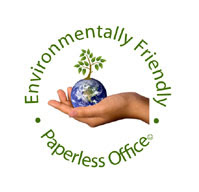Paperless Trail - Going green with SharePoint
A paperless office is a work environment in which the use of paper is eliminated or (more realistically) greatly reduced.
You achieve this by converting your documents and other papers into digital form. By “going paperless” you can …
- Save money (paper, printers, inks and toners)
- Boost productivity
- Save space
- Make documentation and information sharing and searching easier
- Keep personal information more secure
- And, of course, help the environment.
We are now more environmentally aware, we see the production of paper as a significant contributor to deforestation and climate change. We have added measures like recycling and tree-free paper to help reduce the environmental impact, but online document management systems like SharePoint is seen as the strongest contributor in reducing the need for paper.
A solution like SharePoint provides a paperless alternative to …
- Business cards, Index cards and Rolodex
- Typed/written letters and faxes
- Diaries and schedules
- Training material
- Reference books
- LOB documentation for sharing and collaboration
- Record keeping
- Paper-based processes
Providing an alternative to paper-based processes that rely on forms, applications and surveys provides a solution to the biggest hurdle in having a paperless office.
Also, our behaviour is changing. Thanks to the popularity of digital mobile devices like e-books, tablets and smart phones, we are finding it more acceptable to read documents and other information over these mediums – this means that the advantage that paper use to have about being mobile is now phasing away so this paperless office concept is truly possible.
So how do we use SharePoint to achieve a paperless office?
Back scanning (with 3rd party solutions like http://www.kofax.com/) and migrating all your existing records and LOB content into one SharePoint environment is a great first step. Right away you will see the cost saving of phasing out all your existing paper – also when you consolidate all your document storage environments to one digital environment, there are added benefits in having one central point for the users to find and store information, that’s one learning curve and one infrastructure to support and maintain.
Next, you want to convert your manual paper-based processes to more automated SharePoint workflows. The biggest obstacle many organisations face when phasing out paper based processes is the fact that documents needs to be signed to acknowledge acceptance or approval. Tools like InfoPath that integrates well with SharePoint, provides digital signature capabilities with additional security features like making the signature become invalid if the information on the form has changed.
Once the workflows are in place, your business will produce less paper, and the processes would have better control and faster turnaround time. So that’s a saving on cost and time.
I mentioned earlier how the main advantage of paper, i.e. the mobility of paper, is slowly phasing away due to electronic mobile devices. SharePoint is a web based solution, making it easily accessible to these mobile devices – also, doe to the popularity of this product, there are plenty of apps available for iOS and Android, while the Windows 7 devices come with strong integration features by default.
The only real unavoidable use of paper would be around compliancy around the external companies you will need to interact with, companies and government organisations that follow paper-based processes that needs to be followed for compliancy reasons – maybe in time, when the paperless approach is more mainstream – this can be avoided.





Comments